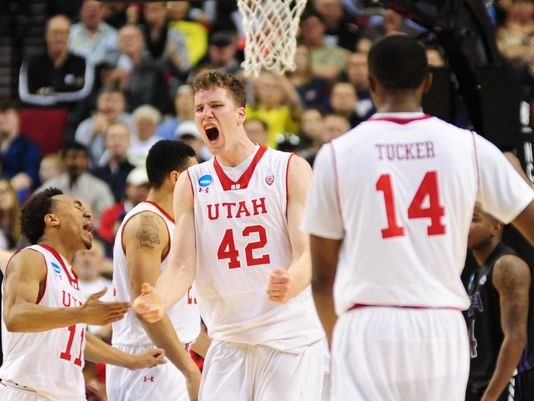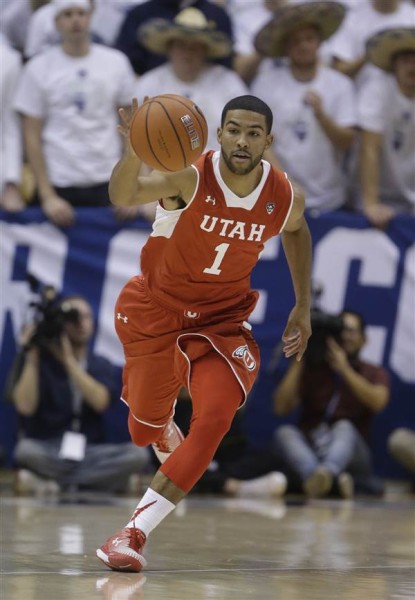Utah Preview: Who’s Got the Wright Stuff?
Posted by Andrew Murawa on October 23rd, 2015In the next three weeks leading up to season tipoff, the Pac-12 microsite will be evaluating each of the league’s 12 teams. Today, we head to Salt Lake City.
Utah Utes
The second team up for our preseason previews is Larry Krystkowiak’s squad, fresh off a third-place conference finish and a Sweet Sixteen appearance. Last season marked the third consecutive year in West Coast Coach K’s four-year tenure in Salt Lake City in which his team’s record has improved. Of the team’s 11 players who averaged better than eight minutes per game last season, nine return. However, the big one who doesn’t is point guard and All-American Delon Wright, who averaged 14.5 points, 5.1 assists, 4.9 boards, 2.1 assists and a block per game, numbers that only begin to sum up his overall importance to the squad.

With Jakob Poeltl Patrolling The Paint, The Utes’ Defense Is A Serious Strength (Godofredo Vasquez, USA Today)
Strengths. As alluded to above, that experience is going to be a huge asset for the Utes. But it is just one of many areas from which this team can draw confidence. Last year the Utes were sixth in the nation in defensive efficiency, largely on the strength of allowing the fifth-lowest effective field goal percentage in the nation. Dig deeper and you also see things like this (courtesy of Hoop-math.com): They were 35th in the nation in fewest three-point attempts allowed; they allowed the 25th-lowest field goal percentage on shots at the rim and were 20th in the nation at shots blocked at the rim; and, they forced their opponents to take the 25th-highest percentage of two-point jumpers. To sum it up, this was a team that closed out on shooters at the arc, forced opponents inside the three-point line, and then used their front line size (highlighted by freshman center Jakob Poeltl) to greatly inhibit shooters’ effectiveness around the rim. Utah loses one of the nation’s elite perimeter defenders with Wright now gone, but the guys expected to take over for him are athletic and long wings. If Krystkowiak’s perimeter defense can be roughly equivalent to last year, scoring against the Utes in the paint will likely be just as difficult. On the other end of the court, the team’s biggest strength last season was its three-point shooting. Three different players – Brandon Taylor, Jordan Loveridge and Dakarai Tucker – shot at least 37 percent from three on at least 108 attempts. They all return, but again, Wright’s ability to penetrate and draw multiple defenders certainly opened up clean looks for them around the arc. If they can again find good looks, the Utes should be able to maintain one of their biggest strengths.
Weaknesses. Even while mentioning those strengths, we had to throw in a few “buts” related to the role Delon Wright played in creating them. And on a team last year without a lot of obvious weaknesses, replacing the do-everything guy who magnified those strengths is going to be the big question. There is no singular replacement for everything Wright did, but the spotlight will certainly fall on three specific players. First, there’s sophomore guard Isaiah Wright who was good, even if little used, in his 12 minutes per game last year. He’s a smart, pass-first, floor general type of point guard who could step into a starting role early. The favorite to be the starter long term is JuCo transfer Lorenzo Bonam, who can do some of the same things that Wright did last season. He’s a terrific penetrating point guard who is capable of finding open shooters off the bounce, but early reviews indicate that he still needs to improve his defense to win the coaches’ favor. Then there’s Gabe Bealer, another JuCo transfer, who coincidentally hails from the same junior college (City College of San Francisco) that Delon Wright came from. Bealer is not a point guard – more of a wing – but if Taylor slides over to the point, he could become a part of the starting lineup as well. A fourth name to remember: Brandon Miller, a 20-year-old point guard ready for his freshman year after a two-year LDS mission. Regardless, the goal for this group is not to “replace Delon Wright” but to play within themselves and the team framework to mitigate some of the question marks trailing Wright’s departure.

Isaiah Wright Is One Of Many Options To Help Pick Up The Slack After Delon Wright’s Graduation (Rick Bowmer, AP Photo)
Non-Conference Tests. Remember Krystkowiak’s first couple of years in Salt Lake City? The Utes played Boise State and BYU in the non-conference slate and not a whole lot else – and no one could blame him while he was still in full rebuilding mode. Those days are now long gone and Krystkowiak is showing himself to be an aggressive scheduler. Aside from a mid-November appearance in the Puerto Rico Tip-Off (where the Utes will open with Texas Tech, then face either Miami or Mississippi State, with teams like Butler and Minnesota on the other side of the bracket), there are four significant tests prior to conference play. First, there’s a visit from San Diego State as part of the ESPN Tip-Off Marathon. Then there’s the annual basketball version of the Holy War with BYU. Then, on back-to-back weekends in December, there’s a trip to Wichita State followed up with a visit to Duke’s home-away-from-home at Madison Square Garden. The rest of the schedule features the usual patsies, but this is still a solid non-conference slate.
Toughest Conference Stretch. The Utes open conference play with a trip to Stanford on New Year’s Day, followed by a visit across the Bay to Cal two days later. Then, instead of getting to head to home sweet Huntsman, they head to Boulder to face their geographic “rival” Colorado. When they finally get home, they’re faced with a tough one-two punch of Oregon and Oregon State. A good start in conference play will be hard to come by this season.
Biggest Story. Aside from the challenge of replacing Delon Wright, it has to be the development of three potentially studly sophomores. Between Poeltl, Brekkot Chapman and Kyle Kuzma, Krystkowiak has some serious fire power. Poeltl, you probably know about. He’s got a good chance of being an NBA Lottery pick due to his mixture of size, athleticism and skill, but he’s also got plenty of untapped upside. While showing great hands and footwork as a frosh, he’s yet to consistently turn that into offensive production. If he can turn into a guy who can consistently produce points in the halfcourt, watch out. Chapman is a skilled combo forward who could create mismatches based on whether he plays the three or the four. He can step out and knock in the three (18-of-50, 45% from deep last year), but he’s also go the ability to get to the rim (where he scored at a 63 percent clip as a skinny freshman) or convert from two with a varied mid-range game. Then there’s Kuzma, an aggressive 6’9” combo forward who was a close second to Wright last season in usage rate, albeit in limited minutes. If his usage and efficiency stay the same while his minutes increase, he could be among the most improved returnees in the conference. Certainly there have been plenty of examples of sophomores slumping after successful rookie campaigns, especially when success has come quickly. If even two of those three can avoid a sophomore slump and take a stride forward, the sky is the limit for this season’s Utes.
If Everything Goes Right… Like we just said: The sky is the limit. Replacing Wright is certainly a major task. But if the Utes can come up with an acceptable combination of players in that backcourt spot and if those sophomores succeed, things are off to a good start. And then there’s Jordan Loveridge. After a promising freshman season where he used a quarter of Utah possessions on the way to 12 points and seven boards per game, he’s watched his usage slip each year since to the point where he was little more than a three-point specialist last season (nearly 60 percent of his shots came from three-point range). He’s a terrific shooter, that’s for sure, but he’s got so much more game than just that single dimension. If his senior campaign puts his entire range of talents on display alongside the positives, this Utah team has Final Four potential.
If Nothing Goes Right… Say that no efficient, dependable solution ever arises at the point. Say that Loveridge (and classmate Taylor) do little more than launch threes. Say that sophomore Poeltl is the same as freshman Poeltl. Worse yet, say that Poeltl gets hurt or struggles with foul trouble; there is precious little talented size behind him on this roster. There’s enough talent on this team that a freefall down the standings is probably out of the question, but this conference is good enough so that if enough things go south on a number of outstanding questions, they could slide to the middle of the Pac.
Projected Starting Lineup
- PG Lorenzon Bonam (Jr, 6’4, 215 lbs)
- SG Brandon Taylor (Sr, 5’10” 167 lbs, 10.6 PPG, 3.3 APG, 43.2 3P%)
- SF Dakarai Tucker (Sr, 6’5” 195 lbs, 7.2 PPG, 2.4 RPG, 37 3P%)
- PF Jordan Loveridge (Sr, 6’6” 222 lbs, 10.0 PPG, 3.9 RPG, 43.5 3P%)
- C Jakob Poeltl (So, 7’0”, 235 lbs, 9.1 PPG, 6.8 RPG, 1.9 BPG, 68.3 2P%, 15.8 OR%, 8.9 Blk%)
The one guy we haven’t talked about here much is Tucker, so let’s give the senior his due. He is mostly just a shooter offensively (in addition to his three-point shooting, he shoots 58.5 percent from two and 81.8% from the line), but he’s capable of chipping in on the glass and is also a terrific perimeter defender. In short: glue guy extraordinaire.
Key Reserves
- F Brekkot Champan (So, 6’8” 200 lbs,)
- F Kyle Kuzma (So, 6’9” 210 lbs)
- PG Isaiah Wright (So, 6’2” 177 lbs)
- PF Chris Reyes (Jr, 6’7”, 230 lbs)
- G/F Gabe Bealer (Jr, 6’6” 180 lbs)
How freaking deep is this team? Goodness! Chris Reyes is likely the ninth man on this squad (which probably isn’t close to being true – he may start) and he’s one of my favorite players in the league. Chapman and Kuzma have breakout potential. Bealer will earn playing time just based on versatility and athleticism. And then Wright will be in the mix to start at the one. That’s 10 deep here and not even mentioned: Kenneth Ogbe, a wing who averaged 13 minutes per game last season and still has upside to grow into; or Brandon Miller, that LDS mission returnee who can play a little point, can play a little two and can score from anywhere on the court. This team is both deep and talented.










































